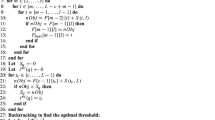Abstract
Robust principal component analysis (RPCA), a method used to decompose a matrix into the sum of a low-rank matrix and a sparse matrix, has been proven effective in modeling the static background of videos. However, because a dynamic background cannot be represented by a low-rank matrix, measures additional to the RPCA are required. In this paper, we propose masked RPCA to process backgrounds containing moving textures. First-order Markov random field is used to generate a mask that roughly labels moving objects and backgrounds. To estimate the background, the rank minimization process is then applied with the mask multiplied. During the iteration, the background rank increases as the object mask expands, and the weight of the rank constraint term decreases, which increases the accuracy of the background. We compared the proposed method with state-of-art, end-to-end methods to demonstrate its advantages.


Similar content being viewed by others
References
Barnich, O., Van Droogenbroeck, M.: Vibe: a universal background subtraction algorithm for video sequences. IEEE Trans. Image Process. 20(6), 1709–1724 (2010)
Bianco, S., Ciocca, G., Schettini, R.: How far can you get by combining change detection algorithms? In: International conference on image analysis and processing, pp. 96–107. Springer (2017)
Bouwmans, T., Zahzah, E.H.: Robust pca via principal component pursuit: a review for a comparative evaluation in video surveillance. Comput. Vis. Image Underst. 122, 22–34 (2014)
Boykov, Y., Kolmogorov, V.: An experimental comparison of min-cut/max-flow algorithms for energy minimization in vision. IEEE Trans. Pattern Anal. Mach. Intell. 26(9), 1124–1137 (2004)
Cabral, R., De la Torre, F., Costeira, J.P., Bernardino, A.: Unifying nuclear norm and bilinear factorization approaches for low-rank matrix decomposition. In: Proceedings of the IEEE international conference on computer vision, pp. 2488–2495 (2013)
Candès, E.J., Li, X., Ma, Y., Wright, J.: Robust principal component analysis? J. ACM (JACM) 58(3), 11 (2011)
Gu, S., Zhang, L., Zuo, W., Feng, X.: Weighted nuclear norm minimization with application to image denoising. In: Proceedings of the IEEE conference on computer vision and pattern recognition, pp. 2862–2869 (2014)
Hofmann, M., Tiefenbacher, P., Rigoll, G.: Background segmentation with feedback: the pixel-based adaptive segmenter. In: 2012 IEEE computer society conference on computer vision and pattern recognition workshops, pp. 38–43. IEEE (2012)
Huang, S.S., Fu, L.C., Hsiao, P.Y.: Region-level motion-based background modeling and subtraction using mrfs. IEEE Trans. Image Process. 16(5), 1446–1456 (2007)
Javed, S., Oh, S.H., Sobral, A., Bouwmans, T., Jung, S.K.: Or-pca with mrf for robust foreground detection in highly dynamic backgrounds. In: Asian conference on computer vision, pp. 284–299. Springer (2014)
Kim, E., Lee, M., Oh, S.: Elastic-net regularization of singular values for robust subspace learning. In: Proceedings of the IEEE conference on computer vision and pattern recognition, pp. 915–923 (2015)
Lim, L.A., Keles, H.Y.: Learning multi-scale features for foreground segmentation. Pattern Anal. Appl. 23, 1369–1380 (2020)
Mandal, M., Saxena, P., Vipparthi, S.K., Murala, S.: CANDID: robust change dynamics and deterministic update policy for dynamic background subtraction. In: 2018 24th international conference on pattern recognition (ICPR), pp. 2468–2473. IEEE (2018)
Oh, T.H., Tai, Y.W., Bazin, J.C., Kim, H., Kweon, I.S.: Partial sum minimization of singular values in robust pca: algorithm and applications. IEEE Trans. Pattern Anal. Mach. Intell. 38(4), 744–758 (2015)
Peng, C., Chen, C., Kang, Z., Li, J., Cheng, Q.: Res-pca: a scalable approach to recovering low-rank matrices. In: Proceedings of the IEEE conference on computer vision and pattern recognition, pp. 7317–7325 (2019)
Romero, J.D., Lado, M.J., Méndez, A.J.: A background modeling and foreground detection algorithm using scaling coefficients defined with a color model called lightness-red-green-blue. IEEE Trans. Image Process. 27(3), 1243–1258 (2017)
Seo, J.W., Kim, S.D.: Dynamic background subtraction via sparse representation of dynamic textures in a low-dimensional subspace. Signal Image Video Process. 10(1), 29–36 (2016)
Shang, F., Cheng, J., Liu, Y., Luo, Z.Q., Lin, Z.: Bilinear factor matrix norm minimization for robust pca: algorithms and applications. IEEE Trans. Pattern Anal. Mach. Intell. 40(9), 2066–2080 (2017)
Shen, Y., Wen, Z., Zhang, Y.: Augmented Lagrangian alternating direction method for matrix separation based on low-rank factorization. Optim. Methods Softw. 29(2), 239–263 (2014)
Shoushtarian, B., Bez, H.E.: A practical adaptive approach for dynamic background subtraction using an invariant colour model and object tracking. Pattern Recognit. Lett. 26(1), 5–26 (2005)
St-Charles, P.L., Bilodeau, G.A., Bergevin, R.: SuBSENSE: a universal change detection method with local adaptive sensitivity. IEEE Trans. Image Process. 24(1), 359–373 (2014)
Stauffer, C., Grimson, W.E.L.: Adaptive background mixture models for real-time tracking. In: Proceedings. 1999 IEEE computer society conference on computer vision and pattern recognition (Cat. No PR00149), vol. 2, pp. 246–252. IEEE (1999)
Toyama, K., Krumm, J., Brumitt, B., Meyers, B.: Wallflower: principles and practice of background maintenance. In: Proceedings of the seventh IEEE international conference on computer vision, vol. 1, pp. 255–261. IEEE (1999)
Wang, K., Gou, C., Wang, F.Y.: M\(^{4}\)CD: a robust change detection method for intelligent visual surveillance. IEEE Access 6, 15505–15520 (2018)
Wang, Y., Jodoin, P.M., Porikli, F., Konrad, J., Benezeth, Y., Ishwar, P.: Cdnet 2014: an expanded change detection benchmark dataset. In: Proceedings of the IEEE conference on computer vision and pattern recognition workshops, pp. 387–394 (2014)
Zhou, X., Yang, C., Yu, W.: Moving object detection by detecting contiguous outliers in the low-rank representation. IEEE Trans. Pattern Anal. Mach. Intell. 35(3), 597–610 (2012)
Zivkovic, Z.: Improved adaptive Gaussian mixture model for background subtraction. In: Proceedings of the 17th international conference on pattern recognition, 2004. ICPR 2004., vol. 2, pp. 28–31. IEEE (2004)
Acknowledgements
Myungjoo Kang was supported by the National Research Foundation of Korea (2015R1A5A1009350, 2017R1A2A1A17069644).
Author information
Authors and Affiliations
Corresponding author
Additional information
Publisher's Note
Springer Nature remains neutral with regard to jurisdictional claims in published maps and institutional affiliations.
Rights and permissions
About this article
Cite this article
Ahn, H., Kang, M. Dynamic background subtraction with masked RPCA. SIViP 15, 467–474 (2021). https://doi.org/10.1007/s11760-020-01766-5
Received:
Revised:
Accepted:
Published:
Issue Date:
DOI: https://doi.org/10.1007/s11760-020-01766-5




